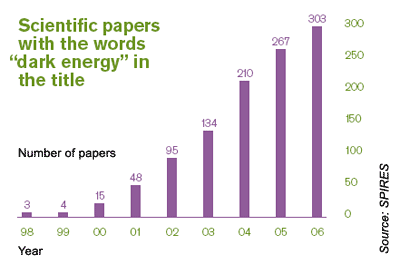 |
A tale of dark energy
In the 1990s, astronomical observations revealed that the expansion of the universe is accelerating. Not knowing what causes this acceleration, scientists began to attribute the phenomenon to some unknown source of energy, coined "dark energy" by astrophysicist Michael Turner.
According to the spires database, the first three papers to contain the words "dark energy" in the title were published in 1998: a Physical Review D article by Turner and Dragan Huterer; an article by Turner summarizing his talk at the Stromlo Symposium; and a Lawrence Krauss article in the proceedings of the 1998 conference on Weak and Electromagnetic Interactions in Nuclei (WEIN 98). Since then, the number of papers has increased dramatically, often doubling or even tripling from year to year. In 2006, the number of papers with "dark energy" in the title exceeded 300 (see graphic), about 20 percent more than those published in 2005.
Dark energy has captured the imaginations of physicists working in a variety of subfields represented in thespires database. While the majority of dark-energy-titled papers, about three quarters, are submitted to thespires astrophysics phenomenology (astro-ph) e-print archive, 1 in 10 can be found in gravity-quantum cosmology (gr-qc), another 10 percent in high-energy physics theory (hep-th) and 6 percent in high-energy physics phenomenology (hep-ph). Even the condensed matter physics (cond-mat) archive contains a paper with "dark energy" in its title.
Today, there are more than 1000 of these papers on dark energy. A look at the references these papers make to other scientific studies reveals what might be the most influential paper in dark energy research: about one-third of all papers cite "Cosmological Consequences of a Rolling Homogeneous Scalar Field," published by Bharat Ratra and P.J.E. Peebles of Princeton University (Phys. Rev. D 37:3406, 1988).
Heath O'Connell, Fermilab
Click here to download the pdf version of this article.


